
In technology, new advancements are often thought to bring along a “revolution” where things will “never be the same.” Technology does tend to stir things up, so it’s not always an overstatement.
The word “revolution” is especially apt today. Now, more than ever, the world is changing. How people design and make things is not just evolving, but being completely disrupted again. We’re on the cusp of a new (and very real) revolution: It’s the ‘Era of Connection’.
How will people design and make things in the future? It’s helpful to take a look at the past in order to understand the major changes that are on the horizon.
First, there was the ‘Era of Documentation’, which went from pencil, paper, X-acto knives, and wood prototypes and models to CAD. For the first time, you could draw something really precisely and accurately, and realistically share it through geometry, diagrams, and text. However, you still had to make decisions about that design through intuition and plain-old judgement calls because even the best drawing is just that — a drawing.
The mid-1990s brought the ‘Era of Optimisation’. The world of making moved from CAD to digital modelling and 3D. Now you are not only documenting design, but also simulating and analysing how it will be in reality. And those digital models allow you to measure and really improve your designs.
This is where the process stands today, but industries are about to enter the ‘Era of Connection’. In the second era, you made sure your design worked. In the third era, you will ensure you even have the right design. This is not just about the design of independent, isolated items anymore.
Everything is — and will have to be — connected and understood in context. Think “big data” meets “killer digital models”, and you can see where we’re going.
So what is happening to foreshadow this new age of design and making? The signposts are strong and telling.
The way you can produce things — intellectually and physically — is changing. Crowdsourcing and vast global, open collaboration is reaching new heights. Attitudes toward IP are shifting, too.
With Elon Musk as a prime example, inventors and designers are opening access to patents and IP sharing, helping to drive even further innovation where everyone shares their insights and competes on ideas. How is all of this being fuelled?
Infinite computing and increasing amounts of computational access from the cloud, social, and mobile technologies provide growing access and empowerment. The winners will be chosen based on who accomplishes the best idea, not who owns it.
For physical production, the possibilities are endless as the democratisation of manufacturing processes is already in full swing. 3D-printing, robotic, and composite materials are gaining incredible momentum, from prototyping to part development to full-blown production. There’s a more flexible global supply chain and easier access through distributed digital networks.
More of the capital that fuels innovation — money and ideas — is available than ever before through crowdfunding and big data. Investment can happen on a grass roots level — not just waiting for a VC, company, or government decision.
Another sign of disruption is that customers have become incredibly empowered — and there are a lot of them. A new digitally savvy consumer class numbering in the billions is emerging. They know what they want and when they want it.
Most of the time we can deliver it when they want it, too. They care about how things are made and the implications of their choice. It’s a new level of buying power where a purchase can also be a personal statement or allegiance.
Customers are cognisant of carbon footprint, “blood diamonds,” and underage workers in overseas factories.
They are driving how companies choose materials and production, so they can feel they’ve made a responsible purchase.
We are also increasingly (and thankfully) moving away from a disposable society. Products need to return to resiliency and quality. Consumers expect their phone to improve over time and evolve through software — not from buying new hardware. And when they do buy a phone, consumers want more than the device; they expect to build a new relationship with the product and service providers.
The Era of Connection means designing for an ever-increasing web between people, technology, and the world around them. People are connecting to each other through crowdsourcing, social networks, mobile, and more.
They’re connecting to their technology, technology is connecting to technology, and technology is sensing the surrounding world and feeding it back to people. Increasing access to unfathomable amounts of big data and the computing power to use it will deliver even more pertinent information to our connections.
In this new world, the competitive landscape really changes. Anyone can take down a titan. What do I mean by that?
It’s the small product company that makes a car. Or a single architect designing a skyscraper in Thailand. With enhanced access to capital, talent, and processing power, it’s a brave new world for organisations of all sizes.
The balance of power is shifting — and, for once, it’s toward the real innovators instead of the entrenched incumbents.
This circuit of connections and the internet of Things will only be the tip of the iceberg. Hardware and software in their current form will become extinct, instead transitioning to completely integrated products — whether it’s a high-rise or an electronic device.
Design will play the crucial role. Prepare now.
The writer is Vice-President, Strategic Industry Relations, Autodesk.












